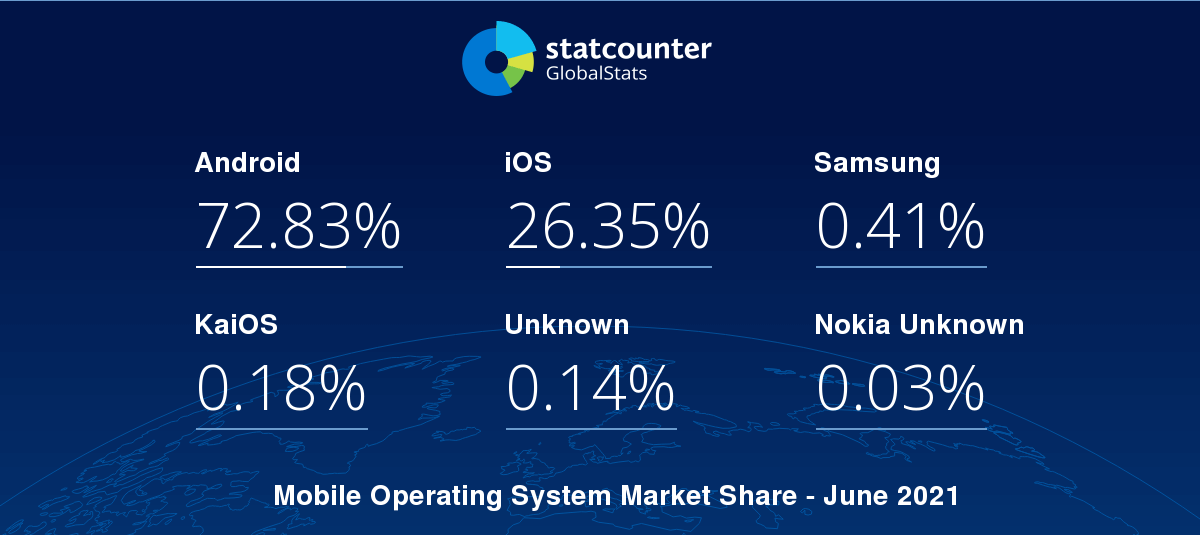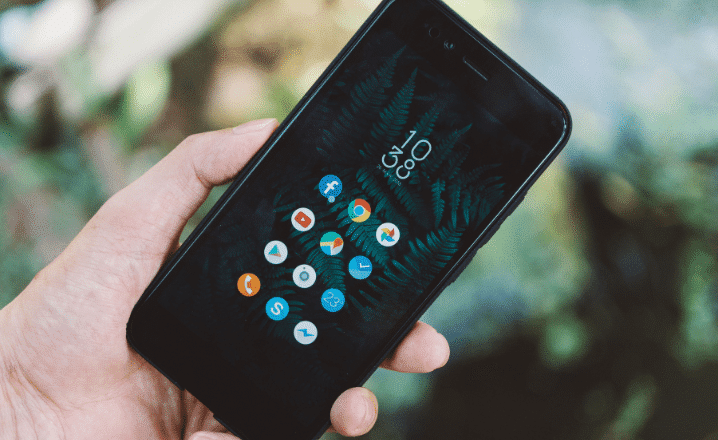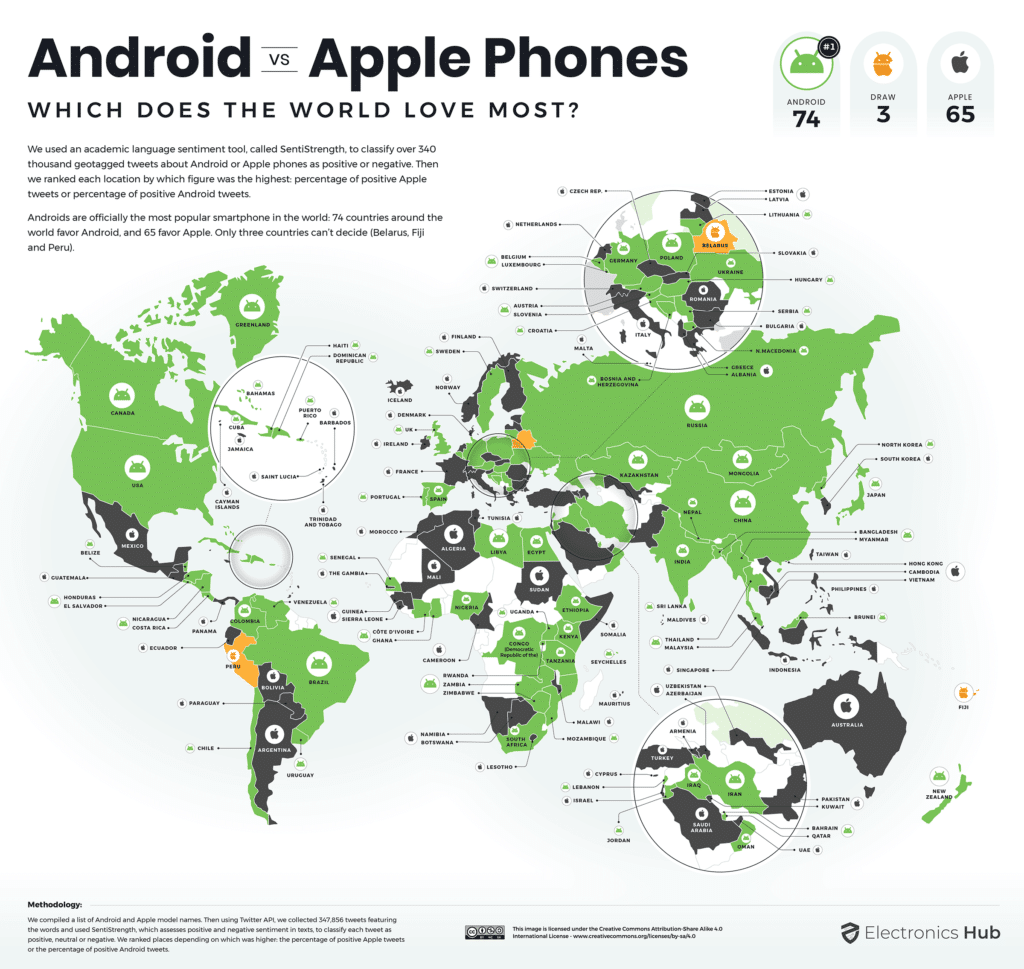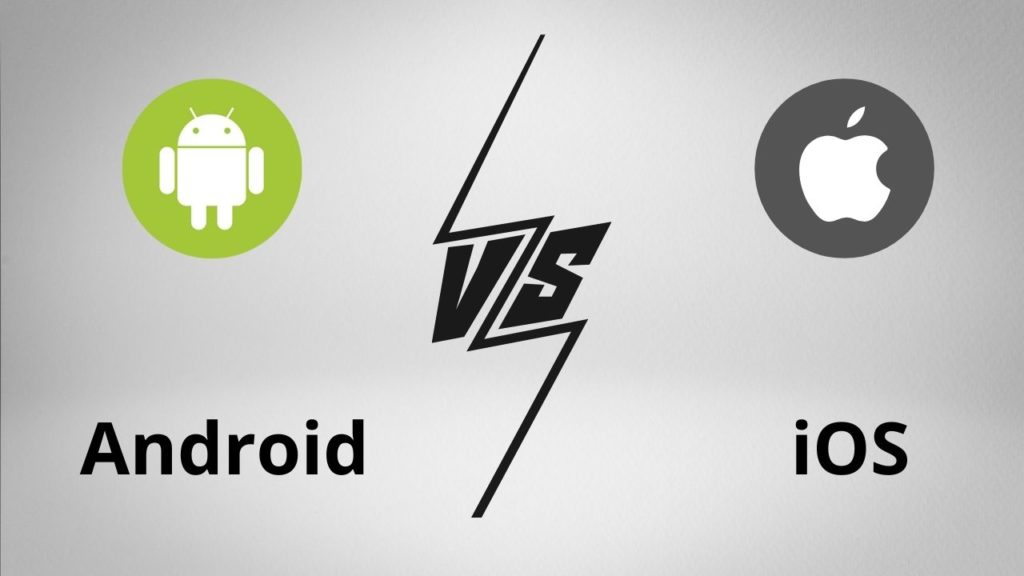Smartphones are now an inseparable part of our life. Globally, around 1.54 billion smartphones are used worldwide and in 2020, 1.38 billion smartphones are sold. Mobile operating systems are the thing that helps to run the phones properly. They are the simpler versions of operating systems used in our computers. They come with the efficiency of computers built to work in a handheld device, making the world shrink to our fingertips. There are many mobile operating systems available on the market today. Android and iOS being the two primary players in the area, have their own separate fan bases putting them on a pedestal worthy of comparison. Android, an operating system partially based on Linux, offers customization according to the taste of the user while iOS has a uniform interface, which makes it more user-friendly. Both Android and iOS jointly own 99% of the world’s mobile OS market share.
But in comparison, over 70% of phone users tend to go for Android devices while only 26% of people prefer iOS for their phone. But when considering iOS is highly dedicated to the premium range of people, the statics may find it difficult to define. Both are fantastic OS, that has their own peculiar features when it comes to usage.

What is Android?

It is an open-source operating system, based on Linux used in mobile phones and can be built by anyone with practical knowledge of coding. But Linux is not Android. Even though it is related, both of them are different and Android is meant for only mobile phones, while Linux usually works in PCs and desktops. In the year of 2007, Google released the first beta version of the Android Software Development kit and in 2008, Android 1.0 was released. The next version was released in 2012 and was named Jelly Bean. The version was more advanced and was updated on many features. Considering all these features, don’t confuse Android with the smartphone we use. Android is never a mobile phone, but it is what we see all inside the phone. The source code for all of these versions are available free and can be used by anyone which makes it more attractive.
Makers usually use java language along with the Android Development Kit to make Android applications. Currently, Android is available in more than 190 countries and works on millions of mobile phones. According to reports of Statcounter, currently, Android holds around 72% global mobile OS market share. Android has several versions and each version is known by its code name. Some of them are Android Marshmallow, Nougat, Oreo, Pie, Android 11 and so on.
Advantages of Android
- The very first advantage of Android is that it is a Linux based open system. It is open-sourced and can be developed by anyone.
- Since it is open-sourced, it provides easy access to android apps for users.
- Google is a giant Internet service provider and has a huge part to play in everybody’s life. Android grants easy access to all google services which makes it more people-friendly.
- It’s highly customisable. Android devices have the features to help us to make customise the device according to our needs and likes.
- Android supports large screens and also comes to people at a reasonable price.
- Offers a separate messaging app for SMS.
- Android is highly usable for entertainment and media-related things.
- Really helpful multitasking. Android devices are always open for multitasking without much fuss.
- Android comes with several widgets and helps to deal with our day to day activities easily.
- Since Android is a favourite mobile OS, huge community support will be available.
Disadvantages of Android
- Android devices allow apps to work in the background which sometimes will be annoying.
- Android makes the battery of the device drain fast due to the high amount of background running of applications.
- Android offers less security and most of the time, personal data security is compromised for the smooth running of devices and applications.
- Low-specification devices have a very slow run with Android.
- Google Account is mandatory to run Android.
- Coding complex layouts and animations are hard in Android.
- High degree virus threat within Android apps.
What is iOS?

Developed and marketed by Apple, iOS is the second most preferred mobile OS after Android. iOS is considered as a premium OS used in the various devices built by Apple, say, iPhones, iPads and iWatches. It is not an open-source software and is the proprietary software of Apple Inc. At first, the OS was known as iPhone Os and later changed its name to iOS in 2010.
The first version of the OS was released in 2007 with the introduction of iPhones to the market. The introduction marked the advent of touch screens to the market ruled by flip phones, thus initiating a revolutionary change in the digital industry.
iOS is a Unix-based operating system and the iPhone software development kit was released in the year 2008. Version 4 of the iOS came with multitasking features thus introducing FaceTime, the video chatting software. Since a lot of changes are made to the OS in each version making it more advanced day by day. It is very popular among people because of its premium features and high efficiency. Due to this, around 218 million iPhones were sold globally by the end of 2018, thus making it the most successful product in the market.
Advantages of iOS
- iOS comes with an excellent UI response.
- The device comes in a shiny and metal appearance.
- More committed to security. The strict rules and regulations of the iOS system offer a threat-free life for devices from malicious apps and viruses that may cause huge damage to the data in the phone.
- iOS is highly recommended for gaming and business-related matters.
- iOS comes with an efficient battery usage policy and can use the device for long hours without interruption.
- Since iOS devices come with a high-performance battery, the heat generation is very low compared to Android, which makes many users go for iOS devices.
- iOS also allows multitasking on the device and is very useful for people with a busy schedules. Many people love to hear music while working and iOS helps to maintain the habit very much.
- Advanced usage of google maps is possible with iOS. The operating system gives opportunities to users to go into the features of google maps that other OS won’t give.
- The easy user interface, even after several upgrades. The iOS comes with simple and easy-to-use device interfaces and is the best feature offered by iOS.
Disadvantages of iOS
- Since the OS comes in a simple design even after upgrades, not much upgrading is given to the application designs and does not offer trendy designs as in other mobile operating systems.
- The iOS devices offer much-limited performance options when compared to Android and don’t give a computer experience while working on the device.
- Very limited devices. Since iOS is the product of Apple, the OS works only on their devices and does not offer the liberty of using other facilities even if you like it.
- The iOS apps will take up more storage space in the device.
- No NFC is available as in other systems thus making it difficult to establish a connection with nearby devices.
- No inbuilt radio on iOS devices and if users want to listen to it, they have to download it separately.
- No widget is supported in iOS like Android but comes with a lot more restrictions in using external widgets.
Android vs iOS – Comparison Chart
| Android | iOS | |
|---|---|---|
| Developer | Google and Open Source Builds (Developed by Global Mobile Brands) | Apple Inc. |
| Initial release | September 23, 2008 | July 29, 2007 |
| Latest Stable Release | Android 11 | iOS 14.7.1 and iPadOS 14.7.1 |
| Customizability | You can change almost everything. | Limited Customization Unless jailbreak. |
| Source Model | Open Source | Closed, with Open Source Components. |
| File Transfer | Using USB Port, Bluetooth, WiFi Direct, Many File share apps. | Bluetooth, Media files can be transferred using iTunes. Photos can be transferred out via USB without apps. |
| Internet Browsing | Google Chrome by default. Many other browsers are available. | Safari. Other browsers can be download. |
| Map | Google Maps by default. Other maps can also be downloaded. | Apple Maps (default). Other maps can also be downloaded. |
| Available Language(s) | 100+ languages | 40 languages |
| Video Chat | Google Meet and other 3rd party apps. | FaceTime (default in apple devices only) and other 3rd party apps. |
| Virtual Assistant | Google Assistant | Siri |
| Available On | Phones, tablets, smartwatches, TVs. | iPod Touch, iPhone, iPad, Smartwatches, Apple TVs. |
| Calls and messaging | Google Messages. All other 3rd Party apps are also supported. | iMessage, FaceTime (with other Apple devices only). Google Messages. All other 3rd Party apps are also supported. |
| Apps Availability on Store | Google Play Store – 2.89 million apps (more apps are included daily) | Apple App Store – 2.22 million available apps (more apps are included daily) |
| Alternative App Stores and side loading | Several other app stores are available. (e.g. Aptoide, Galaxy Apps, Amazon App Store) | Apple blocks 3rd party app stores. The phone needs to be jailbroken if you want to download apps from other stores. |
| Battery Life and management | Android Mobiles comes with a large battery size and inbuilt battery optimization. | Apple batteries are generally not as big as Androids. However, Apple with ultimate optimization apples manages to provide decent battery life. |
| Open Source | Kernel (Based on Linux), UI, and some standard apps | The iOS kernel is not open source but is based on the open-source Darwin OS. |
| File Manager | Yes. (Stock Android File Manager included on devices running Android) | Files app, limited. |
| Photos & Videos backup | Android Apps are available for an automatic backup of photos and videos. | Up to 5 GB of photos and videos can be automatically back up with the iCloud free version. |
| Security | Monthly security updates. Android software patches are available earliest to Pixel devices. Other Manufacturers tend to lag in pushing these updates. | Occasional security updates. Security threats are rare because iOS is locked and downloading apps out of the App Store is difficult. |
| Rooting or Jailbreak | Access and complete control over your device are available and you can unlock the bootloader. | Complete control over your device is not available. |
| Cloud Services | Native integration with Google Drive storage. Free 15 GB of Storage is provided. | Native integration with iCloud. 5GB free. |
| Biometric Authentication | Fingerprint, Face Authentication. Availability depends on the manufacturer’s hardware. | Fingerprint or Face Authentication. Touch ID available on iPhone (5s and later) and iPad (Air 2 and later) but not on iPhone X or later. Face ID available on iPhone X and later, replacing Touch ID |
| OS Family | Linux | OS X, UNIX |
| Headphone Jack | Some current Android smartphones stopped giving this. | Apple removed the headphone jack from iPhone 7. |
Android vs Apple Phones Usage World Map
According to Electronics Hub, they have used SentiStrength, an academic language analysis tool, to analyze 347.856 brand-related tweets around the globe for positive and negative feelings. SentiStrength assigns short texts a score of 1 to 5, and a negative 1 to 5.

Which is Better iOS or Android?
This is one of the best debatable topics that is going on for decades now. Both Google and Apple have great app stores. Android organizes apps better. It lets you place important apps on your home screen and hide the less useful apps in your app drawer. Android widgets are also more useful than Apple’s.
Do iPhones last longer than Androids?
iPhones tend to last longer than any Android phone. Apple’s dedication to quality is the reason for this. According to Cellect Mobile US data, iPhones offer better durability and longer battery life. They also have excellent after-sales service. iPhones are less prone to viruses and malware. Every android device starts lagging after a few years, but iPhone will give the same experience after many years also.
Why is Apple so Expensive in India?
Apple doesn’t have a local manufacturing facility in India. Foxconn and Wistron were awarded contracts to build the iPhone 7 and iPhone SE smartphones. These devices are quite affordable because they are made here. These phones still require imported components and printed circuit board assemblies (PCBAs) to function.
Apple raised the price of its iPhone 11 series in April as the Indian government increased the goods and service tax (GST), from 12% to 18%. The Indian government raised the goods and services tax (GST) by 5%, increasing iPhone prices.
Apple is today a top tech brand, and an iPhone is a fashion statement. Apple offers a unique ecosystem with security that few others can crack, but that is not enough for Indian buyers.
Apple also maintains substantial profit margins for smartphones, which industry experts estimate to be around 500%.
The iPhone’s price difference between India and Japan is due to currency depreciation.



